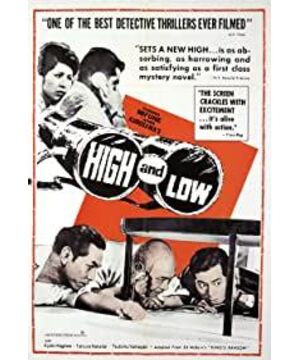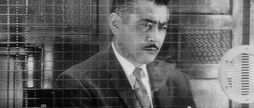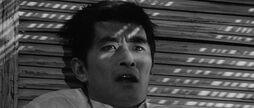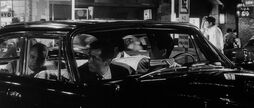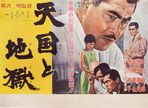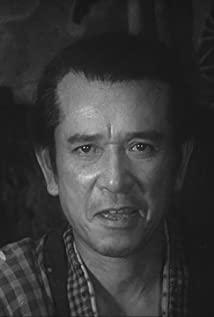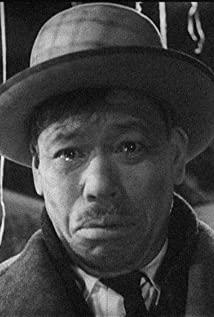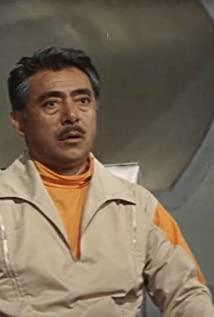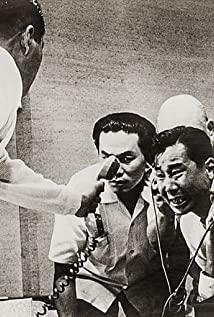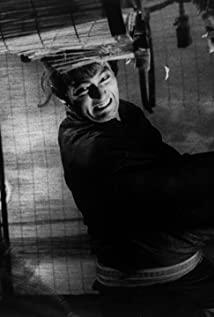Often regarded as the most “Western” of Japanese directors (Bordwell, 379), throughout his career, Akira Kurosawa had demonstrated to the world his illustrious aptitude for incorporating western culture into his films to create a distinct cinematic language both stylistically and symbolic. many of his antecedent films, such as R ashomon ( 1950) and Thr one of Blood (195 7), epitomized his keen assimilation of classic western literature and philosophical ideas, in High and Low (Akir a Kurosawa, 1963) Kurosawa showed off his superb mastery of cinematography, mise-en-scene, and editing in translating character's psychology and implicit meanings unobtrusively, making it truly a film of its time.
High and Lowcan be demarcated into two very different but both equally phenomenal halves. The first act is a seemingly theatrical drama that follows Gondo (Mifune Toshiro), a business executive at a shoe company whose chauffeur's son is kidnapped in place of his own in the midst of his ambitious leveraged buyout in gaining control of the corporation. Although the first half of the film's narrative is entirely set in Gondo's resplendent mansion, it does not prevent Kurosawa from portraying each character's internal emotions through appropriate blocking and frame composition. Having realized that it is the chauffeur's son (Shimazu Masahiko) who ended up missing, in the frame where Gondo is about to answer the call from the kidnapper (Yamazaki Tsutomu) with the chauffeur (Sada Yutaka), the assistant (Mihashi Tatsuya),and the chief detective (Ishiyama Kenjiro) surrounding him, Kurosawa aptly employs blocking to embody their inner psychology that is congruous with their characteristics. Gondo, the main figure who is responsible for paying the ransom, is placed in the foreground of the image, while Aoki, the most agitating one, is in the back center yearning for any possible information. Such spatial relationships present the two central figures to the conflicts, and, at the same time, accentuate the power hierarchy between the two. Gondo is the one who overrules everything, as he is exercising his agency in answering the call, yet Aoki, a menial salaryman who is not relevant to any negotiations, is held off at a distance. Two remaining characters are also deliberately placed to not only fill up the frame but also reveal their motivations. From the beginning,we have already known that Kawanishi (the assistant) is working in collusion with Gondo's opponents to go against him. Hence, we can clearly see how Kawanishi's position in the frame is consonant with his motivation as he situates at the left corner away from the other three, poking his neck to clandestinely spy for any exploitable intel without explicitly interfering the main action. On the opposite side of Kawanishi is the chief detective, another main figure of the film who aims to rescue the kid without jeopardizing Gondo's assets. Unlike Kawanishi, he sits just in between Gondo and Aoki, striving to resolve the primary conflict. By spacing each individual in these specific positions, the character's natural behavior evinces the nature of their behavior,which is why Kurosawa is considered a master of incorporating mise-en-scene to bestow another layer of meanings upon the surface.
Right in the next scene, combined with orchestrated character movement and punctilious editing, Kurosawa again exhibits his deep understanding of implementing stylistic devices to gain control over the plot progression. When Gondo picks up the phone, rather than let the viewer wait and see what exactly the kidnapper has to offer, the narrative fasts forward to later where everyone has gotten together to review the kidnapper's words in the living room, forming another spectacular scene that captures each individual's reaction and psyche in response to the moral conundrum. At the beginning of the scene, as the chief detective starts to play the recording, an establishing shot of the room is displayed to portray every person's close attention to the kidnapper's response. Being notified about the abductor's perverse demand,Gondo who initially sits beside his family, gradually walks toward the back away from the crowd, realizing that he must now make a difficult choice between the boy and his company. In the next second, however, the scene quickly cuts to a new frame where Gondo and Aoki, parallel with each other, both contemplate where the crisis will end up going. Aoki, having no control over the situation and facing forward anxiously, is hoping Gondo is kind enough to pay the ransom and save his son. Gondo, on the other hand, is more inclined to not pay the ransom for the sake of his company, but also feels guilty for his indifference as he faces backward, avoiding taking on any responsibilities. The empty space in between, like an unmade decision, lingers, just as we are waiting to see how the quandary can be ultimately resolved. Then,just when the kidnapper continues with his threat, Gondo begins to move further back into the frame, as a symbol of deep compunction when hearing his assertion for not paying the ransom over the phone. At the same time, his assistant at the left corner leaves the seat in an attempt to calm him down. Forthwith, the camera again cuts to the same poison ditto, but with Gondo, Aoki, and Kawanishi positioning themselves in relation to each other. Being informed by Gondo's rejection, the distance between Gondo and Aoki stretches to a greater extend, connoting the dichotomy between their self-interest. Yet, as Kawanishi walks toward Gondo, his entrance to the frame breaks the equilibrium. Now, Gondo and Kawanishi are on the left side while Aoki is being left out at the right corner.Such unbalanced frame composition signifies Gondo's strong propensity for not paying the ransom at the moment. After the abductor hangs up the phone, the scene cuts back to the previous establishing shot, but now with Gondo situates at the back of the center and Kawanishi covers up the empty space he left, saturating the frame to its fullest. Throughout the sequence, Kurosawa consciously utilizes the multiple-camera system and the editing to maneuver the entire scene from different vantage points, magnifying the main characters' troubled states meanwhile “allowing the actors to play the entire scene without any interruptions.” (Bordwell, 380)but now with Gondo situates at the back of the center and Kawanishi covers up the empty space he left, saturating the frame to its fullest. Throughout the sequence, Kurosawa consciously utilizes the multiple-camera system and the editing to maneuver the entire scene from different vantage points, magnifying the main characters' troubled states meanwhile “allowing the actors to play the entire scene without any interruptions.” (Bordwell, 380)but now with Gondo situates at the back of the center and Kawanishi covers up the empty space he left, saturating the frame to its fullest. Throughout the sequence, Kurosawa consciously utilizes the multiple-camera system and the editing to maneuver the entire scene from different vantage points, magnifying the main characters' troubled states meanwhile “allowing the actors to play the entire scene without any interruptions.” (Bordwell, 380)
Kurosawa's eminent cinematic language does not just manifest through his manipulation of space, but time as well. Although the narrative in the first half of the film is seemingly linear, it does not prevent him to put small twists to advance the plot. Kurosawa uses the tape recorder as a device to handle the narrative progression. From the scene aforementioned, we have already seen how he advances the plot by skipping Gondo and the kidnapper's phone call and cutting to the recording directly. In the scene where Gondo and the police are preparing for the ransom delivery the next day. Kurosawa once more employs the tape recorder as a medium to play with the narrative. According to the previous plot, we know that, in the morning, the kidnapper promises to think through Gondo's offer that he will only pay the ransom after first seeing the boy alive.Shortly after, however, the scene has already cut to the evening as the police are preparing the ransom, not letting us have any information about the kidnapper's response yet. It is not until later when the chief detective begins to play the recording, that we then get to be notified apropos of the train delivery and the police's ploy. Another detail worths noticing is at the end of the first act when Gonda picks up his training as an apprentice to hide the powder inside the suitcase for tracking the kidnapper down. Gondo , sitting at the golden ratio spot of the frame, is tweaking the suitcase while others respectively put their works aside, standing upright to pay reverence to his great sacrifice. By carefully staging each character's position and arranging their movement, Kurosawa is able to direct our eyes to where we exactly need to.The extreme contrast of Gondo sitting with everyone else standing also signifies Gondo's downfall as he mocks “It's like I'm starting over already.”
The extraordinary thing about High and Lowth ough is that it does not just focus the narrative on a one man's drama. In Japanese, the film's title is closer to Heaven and Hell, but the English title High and Lowwor ks appositely with Kurosawa's theme. It is a story about wealth and property, hope and despair, good and evil. Unlike most of Kurosawa's samurai epics which embody a clear boundary of right and wrong,High and Lowis full of contrast and ambivalence. Is the kidnapper's motif purely stemmed from jealousy? Is the fact that Gondo decides to pay the ransom due to a sudden epiphany or from his intention to collect sympathy from the public? Is it ethical for the police to postpone the apprehension just for the sake of getting the death sentence on the kidnapper that wind up causing another woman's life? At the end of the day, there are no definitive answers to these questions, and Kurosawa leaves them to our own interpretation.
Reference: Film History, An Introduction by David Bordwell, Kristin Thompson.
View more about High and Low reviews


